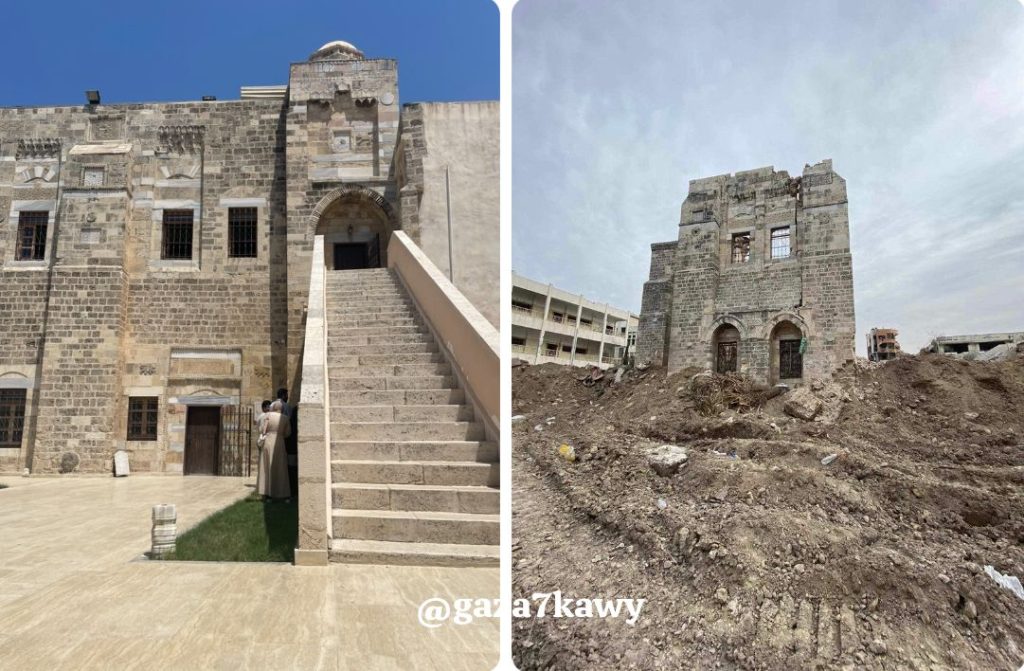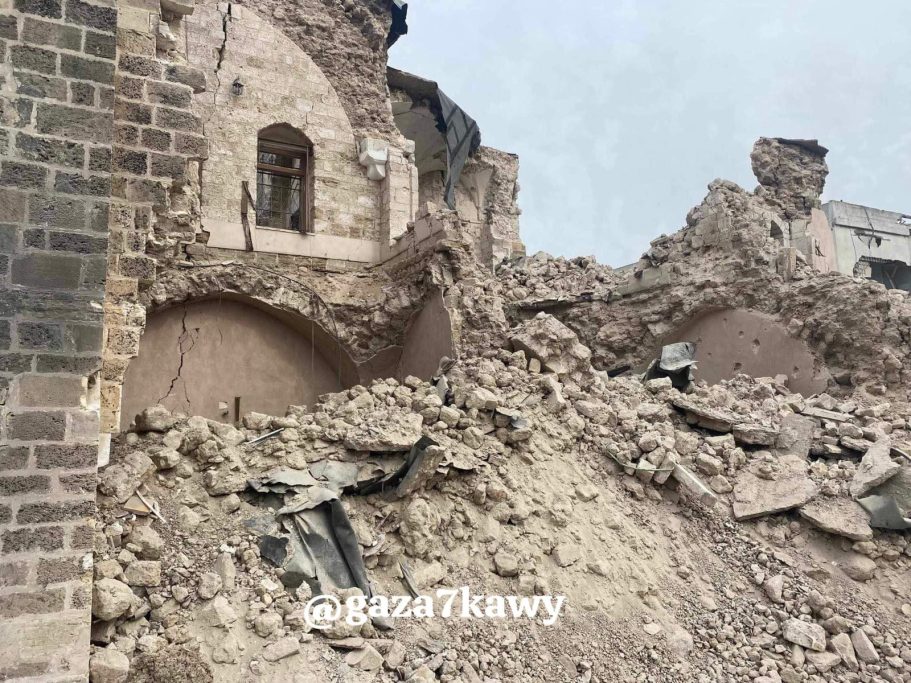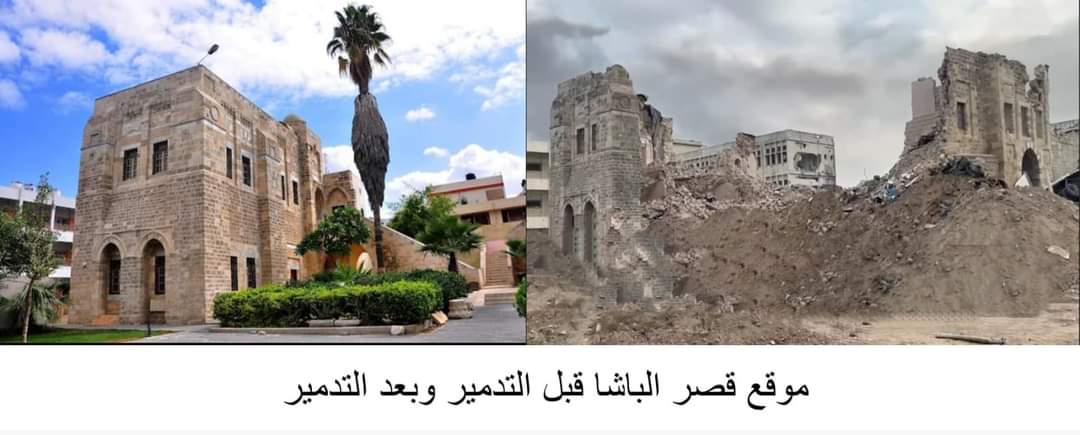By Wafa Aludaini
Since embarking upon its ongoing genocidal aggression against the blockaded Gaza strip last October, the Israeli occupation forces have deliberately attacked at least 200 cultural sites and historical monuments in an effort to eliminate Palestine’s cultural heritage, denying their indigeneity and obliterating any evidence of Palestinians’ historical connection to the land.
The tiny area of the Gaza Strip, which is mere 360 sq.km, includes more than 330 archaeological sites dating back to several historical eras. Gaza is one of the ancient cities of the world, and throughout history was subject to the rule of the Pharaohs, Greeks, Romans, Byzantines, and eventually Islamic rule. Historically, the Gaza Strip was considered a point of contact between Egypt, the Levant, and the Arabian Peninsula, in addition to being a seaport for communication with ancient Greek and Roman Europe.
The precious scant remains of the hundreds of destroyed Palestinian historic monuments and ancient sites across the Gaza strip stand as a symbol of Israel’s utter devastation and animosity against anything Palestinian.
The destruction of the monuments and history of Palestine intersects with the racist statements of several Israeli officials and ministers, starting with Benjamin Netanyahu, the prime minister, who considered Oslo a finished agreement and rejected any Palestinian rule in the Gaza Strip. Further statements by the ministers Itamar Ben Gvir and Bezalel Smotrich clearly encourage the transferring of the Gazans to other Arab countries and rebuilding Israeli settlements in Gaza. Israeli foreign minister Israel Katz promoted a plan to build an artificial island off the Gazan coast, while Israeli Heritage Minister Amichai Eliyahu suggested that dropping a “nuclear bomb” on the Gaza Strip is “an option.”
The crux of Israel’s foundational ideology rests on the erasure of Palestinian heritage and history, including looting historical objects and destroying significant historic sites, an activity which remains a crucial project of the Israeli state.
The blatant Israeli attacks against the archeological sites are considered violations of international laws and conventions, according to 1954 The Hague Convention for the Protection of Cultural Property in the Event of Armed Conflict as well as the Second Protocol to the Convention of 1999.
The Euro-Med Human Rights Monitor said in a statement last November that “Israel has deliberately destroyed archaeological monuments in the Gaza Strip as part of its ongoing bloody war in an explicit targeting of Palestinian cultural heritage.” The Geneva-based rights organization emphasized the urgent need for an impartial international investigation into Israel’s violations, in order to pressure Israel to stop its genocide of Palestinians and to ultimately hold it accountable for its genocidal violence.
According to Nariman Khillah, researcher from the Palestinian Ministry of Tourism, the ongoing genocidal onslaught has damaged more than 200 archaeological sites in Gaza, including 100 sites that cannot be restored, and 100 other sites that were partially destroyed, in addition to the destruction of the central archive of the Gaza Municipality.
The Old City of Gaza, well-known for its rich historical sites, including several ancient monuments, was repeatedly targeted by the Israeli occupation via ground shelling and air strikes, leaving many sites damaged or completely destroyed. Among the destroyed monuments is the Al-Omari Mosque, also called the Great Mosque, one of the most important and largest archaeological mosques in Gaza, attacked and destroyed on December 8. For the people of Gaza, Al-Omari represents more than a religious site; it is a focal point for gatherings and cultural activities.
In the vicinity of the mosque, a library containing rare books and manuscripts also was hit in the same Israeli air raid on the Omari Mosque on December 8.
Located in the same area is also the oldest church in Gaza, the Church of Saint Porphyrois, which dates back to the year 406 AD. The ancient church was targeted on October 19 as dozens of Palestinians took refuge inside it. More than 20 Palestinians were murdered in the assault, including Christian and Muslim families who took refuge there to escape the Israeli bombing.
The Hammam al-Sammara, or Samra Bathhouse, the only remaining archaeological bath in Gaza, founded 9 centuries ago, was struck on December 8. Other archeological and ancient sites that were targeted include the Pasha Palace, which dates back to the Mamluk era, specifically the year 1260 AD, and the Al-Sayyid Mosque, the English Cemetery in 1904, the Gaza Municipality Building in 1893.

The Katip Wilaya Mosque is one of the archaeological mosques in Gaza City, located in the Al-Zaytoun neighborhood in the Old City, and it takes up about 377 square meters. Its construction dates back to 1432 AD/835 AH during the era of the Mamluk Sultan Muhammad bin Qalawun, according to the oldest foundational texts found under the minaret. The mosque was partially destroyed on October 17.
On October 19, 2023, an Israeli airstrike flattened the Al-Omari Mosque, another ancient mosque which was in the Mamluk style, in the town of Jabalia, north of the Gaza Strip. Israeli air strikes also targeted the Salim Abu Muslim Mosque in Beit Lahia, in the north of the Gaza Strip. The mosque contained his shrine, dating back about 6 centuries. It was completely destroyed. The Sheikh Saad Mosque in Beit Lahia, which dates back 5 centuries ago, also was partly damaged by the Israeli strikes.
Nariman added that all of Gaza’s museums were partially or completely damaged, including archaeological collections dating from the Canaanites until the British Mandate.
The Department of Antiquities and Manuscripts, in the Ministry of Endowments and Religious Affairs, was directly targeted and hit by occupation airstrikes. Al-Abbas Mosque, which houses the Al-Abbas Historical Library, containing ancient books and some historical manuscripts were completely burned and cannot be restored. The Akkad Museum, which was established 45 years ago and contains more than 3,200 artifacts, was also destroyed.

Nariman concluded, “All our heritage monuments are clearly marked and the Israeli occupation with its advanced weapons can avoid them, but they mean to target them. But no one can hide the truth forever and Gaza will rise again and stand in the face of Israel’s cunning attempts to obliterate Palestinian identity.”
-Wafa Aludaini is a Gaza-based activist and journalist. She contributed this article to the PIC.















